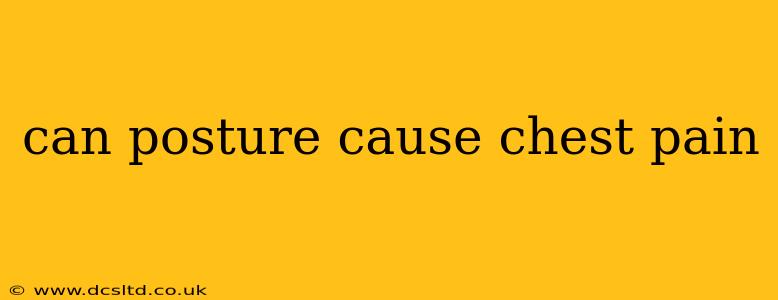Can Posture Cause Chest Pain? Understanding the Connection Between Posture and Chest Discomfort
Poor posture can absolutely contribute to chest pain, though it's crucial to understand that it's rarely the sole cause of significant or persistent chest pain. While a bad posture won't cause a heart attack, it can trigger muscle strain, nerve irritation, and other issues that manifest as chest discomfort. This article will explore the link between posture and chest pain, helping you understand when to seek medical attention.
What Kind of Posture Problems Can Lead to Chest Pain?
Several postural issues can create or exacerbate chest pain. These include:
- Kyphosis (Rounded Upper Back): This hunchback posture puts pressure on the chest muscles and ribs, potentially leading to tightness, pain, and restricted breathing. The resulting strain can be felt as chest discomfort.
- Forward Head Posture: Protruding your head forward strains the neck and upper back muscles, which are connected to the chest via the pectoral muscles. This can cause tension and referred pain in the chest area.
- Rounded Shoulders: Similar to kyphosis, rounded shoulders compress the chest and restrict movement, leading to muscle fatigue and pain that might be perceived as chest pain.
- Lordosis (Swayback): While primarily affecting the lower back, excessive lordosis can indirectly impact posture elsewhere, including the chest. This can result in muscle imbalances and pain that radiates to the chest.
H2: How Does Poor Posture Create Chest Pain?
The mechanisms through which poor posture contributes to chest pain are multifaceted:
-
Muscle Strain and Tension: Poor posture leads to overuse and strain of muscles in the chest, back, neck, and shoulders. This constant tension can cause pain, stiffness, and limited range of motion. These muscles become fatigued and trigger pain signals interpreted as chest pain.
-
Nerve Irritation: Poor posture can compress nerves in the neck and upper back, leading to referred pain in the chest. This type of pain can mimic other conditions.
-
Restricted Breathing: Rounded shoulders and a slumped posture restrict lung expansion, leading to shallow breathing and potential chest tightness or discomfort. This can be perceived as pain, especially during physical exertion.
-
Rib Subluxations: In some cases, poor posture can contribute to the misalignment of ribs, potentially causing localized pain in the chest.
H2: When Should I See a Doctor About Chest Pain?
While posture-related chest pain is often manageable, it's crucial to seek medical attention if your chest pain:
- Is severe or sudden: Sudden, sharp chest pain, particularly accompanied by shortness of breath, sweating, or lightheadedness, requires immediate medical attention. This could indicate a heart attack or other serious condition.
- Is persistent or worsening: If chest pain persists despite postural adjustments or home remedies, it's essential to consult a doctor.
- Is accompanied by other symptoms: Symptoms like nausea, vomiting, dizziness, or shortness of breath alongside chest pain warrant immediate medical evaluation.
- Feels different from your usual pain: Any change in the nature or intensity of your chest pain should be brought to a physician's attention.
H2: What are some other causes of chest pain?
It's important to note that chest pain can stem from various sources beyond posture. These include:
- Heart conditions: Heart attack, angina, pericarditis.
- Lung conditions: Pneumonia, pleurisy, pneumothorax.
- Gastrointestinal issues: Acid reflux, esophageal spasm, hiatal hernia.
- Musculoskeletal problems: Costochondritis (inflammation of the cartilage connecting ribs to the breastbone).
A doctor can perform a thorough evaluation to identify the root cause of your chest pain.
H2: Can improving my posture relieve chest pain?
In many cases, improving your posture can significantly alleviate or even eliminate chest pain stemming from musculoskeletal issues. This often involves:
- Physical therapy: A physical therapist can guide you on exercises and stretches to improve posture, strengthen core muscles, and relieve muscle tension.
- Ergonomic adjustments: Modifying your workspace and daily activities to promote good posture.
- Mindfulness and awareness: Paying attention to your posture throughout the day and actively correcting slouching.
H2: What are some exercises to improve posture?
There are numerous exercises that can improve posture and alleviate chest pain caused by postural issues. Consult a physical therapist for a personalized plan, but some common exercises include:
- Chest stretches: These help counteract the effects of rounded shoulders and improve chest mobility.
- Back extensions: Strengthening back muscles helps support proper posture.
- Neck stretches: Relieving tension in the neck can alleviate referred chest pain.
- Core strengthening exercises: A strong core is essential for maintaining good posture.
Remember, this information is for educational purposes only and should not be considered medical advice. If you're experiencing chest pain, consult a healthcare professional for proper diagnosis and treatment. They can differentiate between postural pain and more serious conditions.
